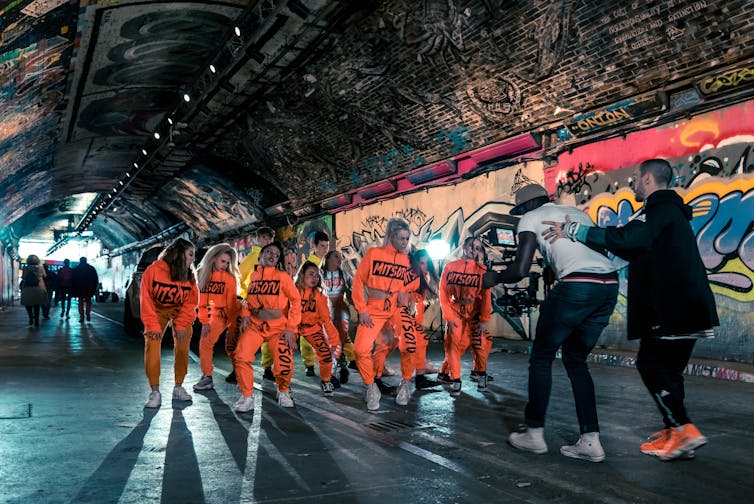How Much Funding Was Cut From Arts Education in 2018
When an emergency back up package for the arts was launched in the face of COVID-19 last July, UK prime minister Boris Johnson trumpeted their value to industry and the nation at big. "They make our country swell," he said. "They are the linchpin of our world-beating and fast-growing creative industries."
Then the government'due south recent proposal to cut funding for arts higher education by 50%, covering music, dance, drama and performing arts, art and blueprint, media studies, and archeology, appears somewhat contradictory.
The immediate damage to the sector from such swingeing cuts in terms of provision and access to arts education – particularly for those on lower incomes who rely on public funding – is clear. Just pedagogy secretarial assistant Gavin Williamson's assertion that arts courses are not among the government'southward "strategic priorities" belies the value of the arts to the United kingdom of great britain and northern ireland, economically and culturally.
This is demonstrated past a range of research, including work I have done on the value of live music equally function of the Arts and Humanities Research Council'south Cultural Value Projection.

Britain's creative industries are a meaning economic driver, a source of cultural value and of diplomatic soft ability. They support private wellbeing and social cohesion, equally has been starkly highlighted during the pandemic.
The government's economic estimates for 2019 showed that, earlier the pandemic, the artistic industries employed 2.1 meg people. This represents an increase of 34.5% from 2011, more 3 times the overall growth rate of employment in the UK overall. In 2018, the sector contributed more than £111 billion to the economy.
The music industry solitary, co-ordinate to trade trunk U.k. Music's figures, contributed £v.8 billion to the economy in 2019, generating £ii.viii billion in export revenue and sustaining 197,168 full-fourth dimension equivalent jobs.
Loftier value
Underlying this economical and social value is an extensive pipeline of arts education. The government-commissioned 2019 Augar Review of didactics implied that many arts courses were of low value. Just to make such broad generalisations ignores the scale at which arts graduates significantly contribute to the sector and to wider club.
A written report on creative-focused universities and colleges showed their graduates add £8.4 billion in income to the U.k.'s economic system each year. And research from Universities UK establish that higher didactics was "the primary producer of the talent and skills that feed the creative industries and an important source of research that informs new ideas, practices and business models".
These contributions are also entwined with arts practice, education and business at a local level. For example, the UK Live Music Census report published in 2018 (which I co-authored) illustrated the extent of the relationships between higher pedagogy and the venues and businesses which support both aspiring and established musicians – an important aspect of the talent pipeline.
Nigh lx% of the venues that responded to the census noted formal or informal links to educational communities, universities and colleges. Local economies, equally well as the national economy as a whole, benefit from these ties.
What's more, only as disentangling the economic and cultural contribution of the arts education is not straightforward, information technology is a mistake to ignore the deeper relationships at work in higher education. In terms of both teaching and enquiry, arts and science subjects do not, equally the Augar review mistakenly suggested, operate independently and at the expense of one another.

On the reverse, students and researchers alike do good from the cross-pollination of ideas and experience. Fifty-fifty beyond cross-subsidy across teaching and research, and across arts and sciences, there'south a degree of mutual do good.
If the authorities acknowledges that the arts are beneficial, information technology should also recognise that hitting arts subjects in HE will dethrone that capacity to contribute to the broader economic system. As well as being invaluable in communicating findings and facilitating public agreement of scientific research, interdisciplinary collaborations across humanities and sciences has led to new initiatives in fields as diverse as climate modify and biology.
The UK'due south research civilization, every bit well every bit its cultural output, is stronger and meliorate equipped to meet the digital challenges and opportunities of the hereafter as a result.
This strength didn't ascend quickly but was the result of longer-term relationships. It won't be easy to recover quickly. The arts have already been battered past the pandemic. A supportive environment is needed that looks at their value strategically, holistically and over the long term. The government'southward own stated priorities of levelling up across the land – forth with equipping the economy as a whole for a competitive, continued international arena – depend on it.
Source: https://theconversation.com/arts-education-is-facing-massive-cuts-yet-its-value-is-felt-everywhere-160844
0 Response to "How Much Funding Was Cut From Arts Education in 2018"
Post a Comment